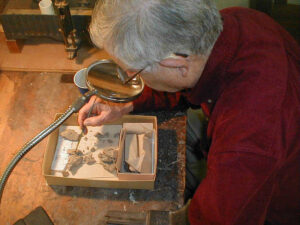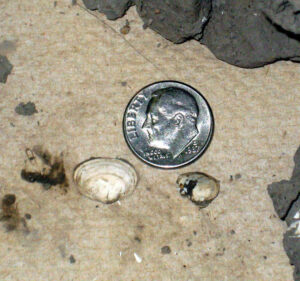 The dead of winter gives us the opportunity to catch up on our lab work. Holmes has been exploring a sample of clay we collected two years ago near the juveniles, and he found some clams inside! These are the first fossil mollusks we’ve seen in the clay. Jim Theler at the University of Wisconsin–La Crosse has identified them as members of the Sphaeriidae family which has two common genera Pisidium or pill clams and Sphaerium or fingernail clams.
The dead of winter gives us the opportunity to catch up on our lab work. Holmes has been exploring a sample of clay we collected two years ago near the juveniles, and he found some clams inside! These are the first fossil mollusks we’ve seen in the clay. Jim Theler at the University of Wisconsin–La Crosse has identified them as members of the Sphaeriidae family which has two common genera Pisidium or pill clams and Sphaerium or fingernail clams.
 In this part of the world fingernail clams are found in all kinds of freshwater—ponds, lakes, rivers and creeks of all sizes; in silt, mud, sand and gravel. Sphaeriidae bury themselves in the bottom and don’t move around much, unlike snails, so they generally serve as good indicators of the habitat (Herrington and Taylor, 1958). Some are highly sensitive to their environment and make excellent environmental barometers of water quality and other environmental conditions (Kilgour and Mackie, 1991). If we can identify the species that will establish its habitat requirements and help define some specific conditions at the site when they were alive (e.g.water chemistry, hydrology, sediments, etc.). It’s a particularly difficult family to classify though–we’ll need a specialist. There are more fingernail clams in our sample—that could be useful too. Funk and Reckendorfer (2008) report a correlation between the shell variation within a population to the temporal and spatial variability of the environment, with stable homogenous environments showing less variability. Stay tuned, we could have a lot of fun with these!
In this part of the world fingernail clams are found in all kinds of freshwater—ponds, lakes, rivers and creeks of all sizes; in silt, mud, sand and gravel. Sphaeriidae bury themselves in the bottom and don’t move around much, unlike snails, so they generally serve as good indicators of the habitat (Herrington and Taylor, 1958). Some are highly sensitive to their environment and make excellent environmental barometers of water quality and other environmental conditions (Kilgour and Mackie, 1991). If we can identify the species that will establish its habitat requirements and help define some specific conditions at the site when they were alive (e.g.water chemistry, hydrology, sediments, etc.). It’s a particularly difficult family to classify though–we’ll need a specialist. There are more fingernail clams in our sample—that could be useful too. Funk and Reckendorfer (2008) report a correlation between the shell variation within a population to the temporal and spatial variability of the environment, with stable homogenous environments showing less variability. Stay tuned, we could have a lot of fun with these!
Holmes also uncovered some large mussels—Unio sized in the sample. They are highly degraded though and very fragile. Identifying them will also be difficult. If we can though it will help us to further delimit the water and bottom conditions when they were alive.
There are a couple of exciting conclusions we can draw from the presence of these bivalves: 1) The clams grew here and weren’t carried in by the current. They are buried in the same silty clay we find everywhere else at the site indicating the velocity of the water was very slow—not fast enough to transport these far, even with their sail-like shapes—especially the big shells. 2) The fingernail clams are full-grow, they are not the juveniles of fresh water mussels (naiads). They generally live 1-3 years. Were the sloths wading through a soggy wetland or in the shallows of a lake when they met their end? Could this area dry out every summer and the clams still survive? How long can clams “hold their breaths?”Answers to these questions will take us a giant step toward defining another dimension of the sloths’ habitat. . . . Dave
References
Funk, A. and Reckendorfer, W. 2008. Environmental heterogeneity and morphological variability in Pisidium subtruncatum (Sphaeriidae, Bivalvia). International Review of Hydrobiology 93: 188-199.
Herrington, H.B. and Taylor, D.W. 1958. Pliocene and Pleistocene Sphaeriidae (Pelecypoda) from the central United States. Occasional Papers No. 596, University of Michigan Museum of Zoology, 29 pp.
Kilgour, B.W. amd Mackie, G.L. 1991. Relationship between demographic features of a pill clam (Pisidium casertanum) and environmental variables. Journal of the North American Benthological Society 10: 68-80.

There is another intriguing aspect to the clam concentration. I suspect that clams were widespread in the sloth-bearing clays when they were alive but now are only preserved in this relatively small area. For some reason, this portion of the site was not subjected to as much weathering (leaching) as the remainder of the deposit. We have collected both pollen and seeds elsewhere at the site but both are degraded and clearly were subjected to the vicissitudes of nature; specimens of both are sparse. Since the clams are preserved in this area, this matrix sample also probably contains better preserved pollen grains and seeds. A thimble-sized pollen sample can be removed without material damage to any preserved clams. A much larger amount of the clam-bearing matrix will be required to recover any enclosed seeds. Seeds are exceptional paleoenvironmental indicators and also provide our only hope for a radiocarbon date on the deposit. Seed extraction techniques will damage any embedded clams. The quandary: While we will recover more of each, should we emphasize clam or seed recovery?
Very cool! Are you wet screening the clay samples to find small bones, shells, etc ? Any evidence of crayfish burrows? Snail shells? These days we often use benthic macroinvertebrates to help determine water quality. Can we do the same with paleocritters?
Hi Pete, we’ve tested several samples–used seives and floated at least 50# of clay, but as Holmes mentioned, findings were surprisingly meager. This small area by the juveniles seems to have enjoyed better conditions for preserving shells like this. No snails yet. Your work with insect larvae is the kind of thing we hope to accomplish using the clams or microfossils in the clay–diatoms may hold out some promise. We’ll be back digging in this vicinity next month and hope to collect a lot more samples. We may have your crayfish burrow. We’re taking a mysterious cavity full of rocks that we collected to the hospital Friday to be CT scanned. Watch for a report on that soon.